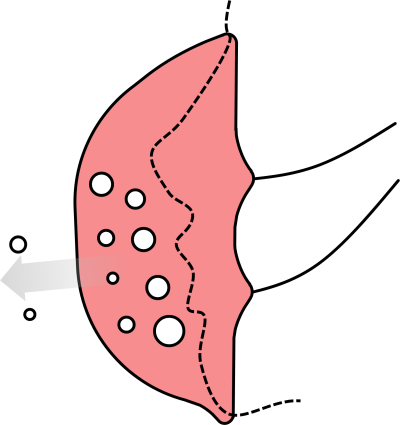

(Photo credit: UBC)
According to the World Health Organization, three layers are optimal for a non-medical mask, consisting of an absorbent inner layer, a protective outer layer and a middle filtration layer. After testing multiple mask designs and 41 fabrics, the UBC research team determined that two layers of low-thread-count quilting cotton, plus a three-ply dried baby wipe insert, filtered up to 80 per cent of 3-micron particles, and more than 90 per cent of 10-micron particles – performance on par with commercial non-surgical masks.
“We focused on particles larger than one micron because these are likely most important to COVID-19 transmission,” said researcher Dr. Steven Rogak, a professor of mechanical engineering who studies aerosols. “While the COVID-19 virus is only around 0.1 micron in size, it is always attached to something larger, like the droplets produced by breathing, talking and coughing, which are typically in the micron and not submicron range.”
For breathability and moisture control, the team recommends certain fabrics for the outer/inner layers: double-knit cotton, quilting cotton, knit nylon or polyester satin for the outer layer, and double-knit cotton, quilting cotton or simple-weave silk for the inner layer. For the filter, they say dried baby wipes are cheap, easy to replace and work surprisingly well.
“Baby wipes are typically made of spunlace and spunbond polypropylene – similar to the types of polypropylene found in medical masks and N95 respirators,” said researcher Dr. Jane Wang, a clinical professor in the faculty of medicine. “They are breathable and trap particles efficiently. They’re biocompatible, containing minimal preservatives and chemicals that may otherwise cause irritation or breathing problems.”
As important as the material is mask fit, the researchers point out. In fact, a well fitting cloth mask outperforms a leaky N95 mask, they say. Trouble areas include around the nose, chin and the cheeks, and pleated-style masks tend to leak the most.
“The mask should not sit flat against your mouth and nose, because it will be less breathable, as there’s only one very tiny portion of the fabric actually exchanging air,” said Dr. Rogak. “Even if it’s made of breathable material, it won’t feel that way. You need to create a bit of an air pocket, with a bigger curvature in front, so that the whole mask is engaged in air exchange.”
To help those making their own non-medical grade masks, the UBC research team have posted an interactive version of their data, and simplified mask design tool, on github. Their research was also published in the journal Aerosol Science and Technology.
www.ubc.ca
